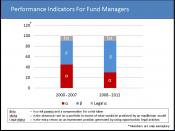�PAGE � �PAGE �1� OP Analysis
Organizational Performance Analysis
Eleanor Baughman, Mayra Cosme
and AnnaMarie Wilber
University of Phoenix
SYS 540
Josue Orraca
March 19, 2007
�
Organizational Performance Analysis
"Organizations can more readily monitor and reposition their operations in fast-paced, competitive environments, when their performance measurement systems provide them with relevant, timely, complete, and accurate information" (Jensen & Sage, 2000). Professor Orraca asked his class to compare and contrast two simulations addressing performance metrics and organizational performance. The first simulation focused on the needs of the University of Santagreen (UoS) and the other focused on Thistle Woods Hospital. This paper will address the indicators of each organization, metrics used for measurements, established standards for measurements, impact of systems thinking and the impact of enhancements on other parts of the organizations. Let us look at each area and how each organization measured up during the simulation.
Performance Indicators
Performance indicators are measurements to quantify business goals.
Indicators can help an organization measure progress towards those goals. They can provide insights for improving processes, as well as meeting customers' needs and satisfaction. To be effective, performance indicators need to be: specific, measurable, achievable, realistic, and timely (Wikipedia, 2007). Additionally, to provide meaning indicators should be tied to the organization's mission statement or corporate goals (UoP Simulation, 2007). What are some of the performance indicators utilized by UoS and Thistle Woods?
The mission of UoS is "the pursuit, promotion and propagation of knowledge through excellence in education processes." The chancellor was concerned with whether or not the university was positioned for the changing educational environment or if they were losing their status of excellence. They identified three key performance indicators:
Graduation Rate - indicator measured by all universities;
Faculty-Student Ration - major differentiator and critical selling point for peer universities; and,
Proportion of minorities to senior positions - attracts a more diverse student body.
Thistle Woods' mission is simple: Honor, Service and Commitment. In order to fulfill this mission, the hospital must continually monitor their performance, particularly in meeting the needs of their patients. The hospital consists of four areas: Emergency Room, Inpatient, Outpatient and Laboratory. Each of the areas had performance indicators measuring their traffic as well a separate indicator for wait times for patients moving between the departments.
To be effective, these indicators can either identify potential problem areas as well as track the overall performance of a process or department. How well are UoS and Thistle Woods doing with their performance metrics?
Metrics
"Metrics are a system of parameters or ways of quantitative and periodic assessment of a process that is to be measured." These metrics can track trends, productivity, and use of resources (Wikipedia, 2007). Metrics can be used to measure the status, and evaluate the effectiveness and progress of the organization. They can be used to establish a good communication with the stockholders and the employees to achieve the organization's goals (Parviz, 2007).
For UoS, they identified that their graduation rate was declining. When comparing year over year and to their peers, the university was on par with the other two ratios, but the other universities were not experiencing the number of drop outs. In order to strategize for the future, they would need to identify the reasons behind the lower graduation rates. By using data provided by standardized industry reports, they were able to then identify specific areas that they could strategize new processes to improve the overall performance of the university.
Likewise, Thistle Woods was considered a leading medical organization, but the new ER administrator sensed that there was room for improvement since they were facing a shortage of beds within the ER. To resolve the situation, management has to evaluate other departments outside of the ER system as well as within ER by analyzing the various traffic logs and process flowcharts.
Established Standards
There are several established standards for measuring success. Early on in an organization's history, a business plan is established that outlines a set of values that lay the foundation for performance standards and provide direct the implementation of the overall plan of action (Businessplans, 2007). Secondly, there are published industry standards. These provide a framework and bench mark for specific processes or measurements with a given industry or business line (DIS, 2007). Both of these lead to the last standard covered: Benchmarking. "Benchmarking is a process used in management and particularly strategic management, in which organizations evaluate various aspects of their processes in relation to best practice, usually within its own sector (Wikipedia, 2007).
In regard to UoS, being able to assess other relevant quantifiable reports in terms of declining graduation numbers assisted the university in applying benchmarks that would over time increase graduation rates. By utilizing documented industry survey results, as well as UoS's survey results, the university was able to identify the specific needs of students, implement new programs that would lead to increased graduation rates.
In regard to Thistle Woods, they had some standards in place; however, they were not able to effectively manage the processes, particularly the performance within the laboratory department. When provided the option of arranging priority services the lab began to effectively work within the processes. However, over time as more patients were added to the laboratory process, another solution was needed. By outsourcing some of the non-emergency needs and building mini-labs provided the hospital, as well as the laboratory, sufficient, cost-effective and efficient means to carry out the overall strategic plan.
Both the UoS and Thistle Woods utilized benchmarking through the analyzing of relevant data either published externally or internally, to determine where improvements within their process and systems were required.
Systems Thinking
Systems' thinking is an approach to analysis that is based on the belief that the component parts of a system will act differently when isolated from its environment or other parts of the system. It includes viewing systems in a holistic manner, rather than through purely reductionist techniques. Systems' thinking is about gaining insights into the whole by understanding the linkages and interactions between the elements that comprise the whole "system." It recognizes that all human activity systems are open systems; therefore they are affected by the environment in which they exist. Systems' thinking recognizes that in complex systems, events are separated by distance and time; therefore, small catalytic events can cause large changes in the system. It acknowledges that a change in one area of a system can adversely affect another area of the system; thus, it promotes organizational communication at all levels in order to avoid the silo effect (Wikipedia, 2007).
Once both organizations were able to think "out side of the box" performance at UoS and Thistle Woods were able to implement a strategy for improving their performance while keeping in line with their mission and goals.
Dual Impact
As previously discussed, systems thinking maintains that a decision made at one point in time, will have an effect on the systems at a later point in time. This is commonly referred to as cause and effect. The systems thinking simulation illustrated this point with a diagram in a circular motion. Consider Thistle Woods, the ER administrator initially changed the system for laboratory referrals from a first time, first out approach to a priority handling approach to eliminate overcrowding in the ER. However, as laboratory needs increased due to increase of inpatients, the lab was once again inefficient in addressing the needs of the patience. While the first change had a positive impact on the overall system, at a future time it proved to be the reason behind looking at the system again for improvement. At this time, the process was furthered enhanced by the clinical reason for the priority - or clinical priority for laboratory tests. As the overall systems were refined, new processes and enhancements are identified and implemented.
With UoS, as areas were identified to be improved, it became apparent the faculty and staff would need training on the significance of the process improvements. Additionally, the changes implemented require staff to beware of how they communicate with students concerning the expectations of their specific degree programs. The changes that UoS wanted to implement required that all systems within the university worked together to improve their graduation rate.
Conclusion
As seen by the two simulations, systems' thinking is critical to identifying performance measurements and implementing metrics. UoS had to use published industry information to help them identify areas of improvement for them to meet the mission and goals of the university. Likewise, Thistle Woods looked at internal metrics and benchmarking to identifying the area that was having the greatest negative impact on the overall performance of the system. While the ER was experiencing the end results of not having enough beds, it cause was identified to be outside of the ER specific system, namely in the laboratory.
"Applying systemic concept such as interdependencies, feedback, and boundaries has made one more aware of the relevance of synthesis-the whole is more than the sum of the parts" (UoP Simulation, 2007). By using a holistic approach, companies can identify problem areas which impact the overall performance. This also applies to identifying performance measures, which can help an organization strategizing for the future by identifying key areas where action can be taken. Organizations need to continually plan and revise to keep up with the ever changing world environment around them.
�
References
Benchmarking. (2007). Wikipedia, the free encyclopedia. Retrieved March 16, 2007 from http://en.wikipedia.org/wiki/benchmarking.
Jensen, A.J. & Sage, A.P. (2000). A systems management approach for improvement of organizational performance measurement systems. Information, Knowledge, Systems Management, 2, 33-61. Retrieved March 12, 2007 from the Business Source Complete database.
Key Performance Indicators. (2007). Wikipedia, the free encyclopedia. Retrieved March 16, 2007 from http://en.wikipedia.org/wiki/keyperformanceindicators.
Lok, P., Hung, R., Walsh, P., Wang, P., & Crawford, J. (2005). An integrative framework for measuring the extent to which organizational variables influence the success of process improvement programmes. Journal of Management Studies, 42(7), 1357-1381. Retrieved March 13, 2007 from the Business Source Complete database.
Metrics. (2007). Wikipedia, the free encyclopedia. Retrieved March 16, 2007 from http://en.wikipedia.org/wiki/metrics.
Rad, P.F. & Levin, G. (Nov 2005). Using metrics as a catalyst achieving successful project performance. allPM.com. Retrieved March 15, 2007 from www.allpm.com/modules.php?op=modload&name=News&file=article&sid=1315.
UoP Simulation. (2007). Apply systems thinking in managerial decision making. Retrieved March 17, 2007 from UoP rEsource website.
UoP Simulation. (2007). Using performance metrics. Retrieved March 17, 2007 from UoP rEsource website.


